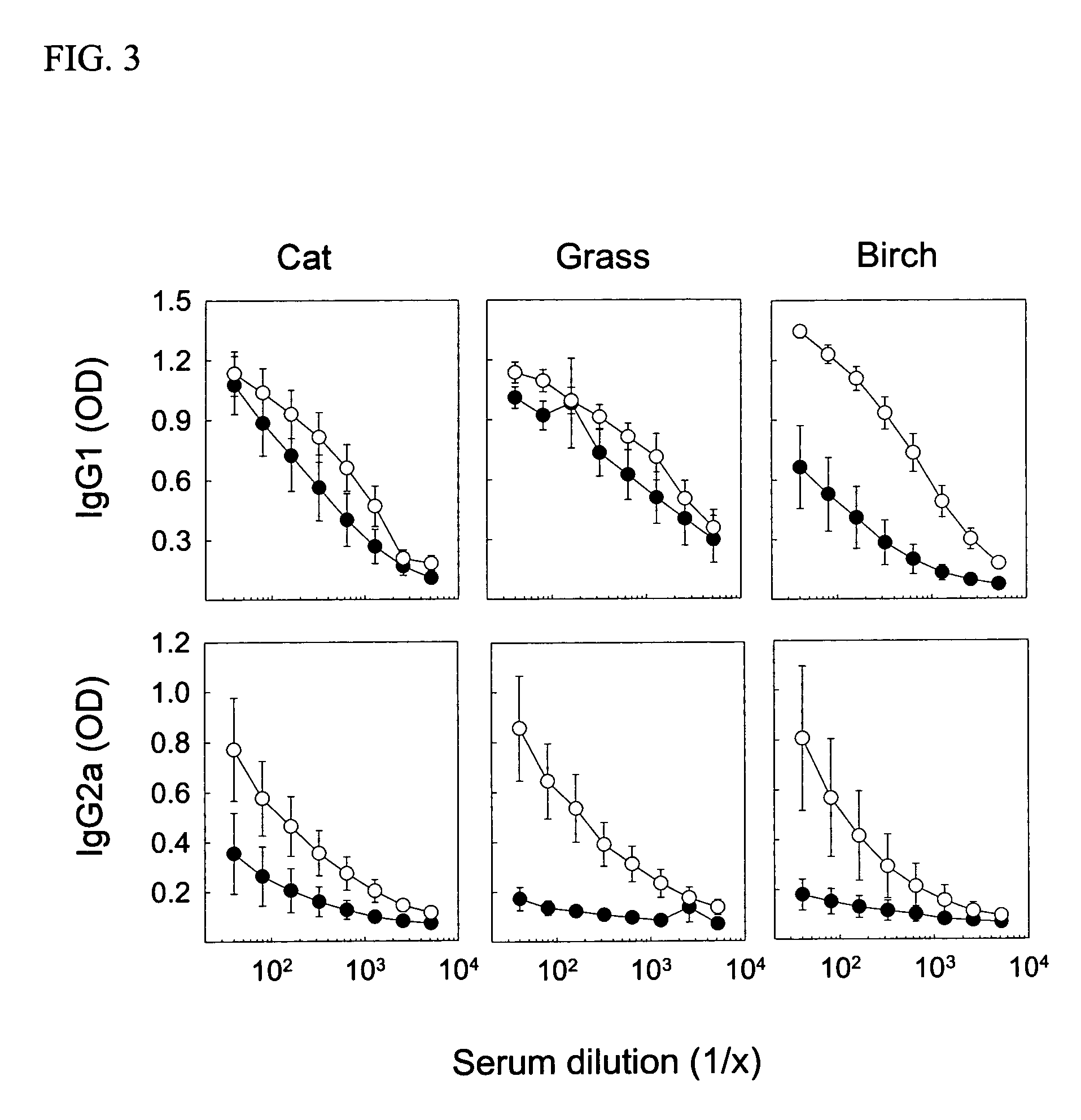Allergen-specific immunotherapy
an immunotherapy and allergen technology, applied in the field of allergen-specific immunotherapy, can solve the problems of high time-consuming conventional sitting, high cost, etc., and achieve the effects of reducing the effect of recombinant technology, and reducing the risk of allergic side effects
- Summary
- Abstract
- Description
- Claims
- Application Information
AI Technical Summary
Problems solved by technology
Method used
Image
Examples
example 1
Immunization Protocols
[0032] Young female CBA / J mice from Harlan (Horst, The Netherlands) were immunized with native or heat-denatured extracts of bee venom and grass pollen (ALK-Abello) and cat dander (Stallergenes) all purchased from Trimedal Ltd (Bruttisellen, Switzerland). Ovalbumin was from Sigma Aldrich (Buchs, Switzerland). Denaturation of concentrated solutions of allergens in saline containing human serum albumin at 60, 80 and 99° C. under agitation was performed using a Compact Thermomixer from Eppendorf.
[0033] The injected allergens were injected with 30% (V / V) of a two percent suspension of aluminium hydroxide (ALU-GEL-S®, Serva, Heidelberg, Germany) in phosphate-buffered saline. For intraperitoneal and intralymphatic injections, 50 and 10 microliter, respectively, of the vaccine was injected; intralymphatic injections were performed on anesthetized (Ketamine and Xylazine) mice. Serum was prepared from clotted blood collected from the tail vein at different time point...
example 2
Antibody Determination
[0035] For detection of antibodies, microtitre 96-well plates (Nunc Maxisorb) were coated at 4° C. overnight with 100 μl of 5 μg / ml of PLA2, 1 μg / ml whole birch pollen extract, 1 μg / ml whole cat dander allergen extract, or 2 μg / ml whole grass pollen extract, respectively, in buffered carbonate (pH 9.4). Plates were washed with PBS-0.05% Tween 20 (PBST) and saturated with 150 μl of 2.5% non-fat dry milk (PBSTM) at room temperature (RT) for one hour. After washing, serial dilutions of individual sera in 100 μl PBSTM were added to the plates, which were then incubated at RT for two hours. Plates were washed and then incubated with 1 μg / ml goat anti-mouse IgG1 or IgG2a conjugated to biotin (BD Biosciences Pharmingen, San Diego, Calif.) in 100 μl PBSTM at RT and for two hours. After further washing and incubation with 100 μl of a 1:1000 dilution of strepatavidin-conjugated HRP (SA-HRP; BD Pharmingen) at RT for one hour, the plates were washed again and added 100 μ...
example 3
Inhibition Assay
[0037] To evaluate the recognition of native and heat-denatured allergens by human antibodies, the allergens were tested in an ELISA inhibition assay and in a Western blot assay. The inhibition assay was performed by coating 96-well plates at 4° C. overnight with 100 μl of a 5 μg / ml PLA2 solution in buffered carbonate, pH 9.4. The plates were then blocked with PBSTM. In a second series of plates, two-fold dilutions of the native and heat-denatured allergens were prepared at 60 μl. These were incubated at 37° C. and for 2 hours with 60 μl of 1:400 dilutions of a sero-positive human serum against bee venom. Subsequently, 100 μl of the antisera-allergen solutions were transferred to the washed and emptied PLA2-coated and blocked plates for further incubation at 37° C. for 2 hours. After discarding the solution and washing the plates, 100 μl of biotinlyated anti-human IgG4 or IgE antibodies were added for 1.5 hour as recommended by the provider (BD Pharmingen). The pla...
PUM
| Property | Measurement | Unit |
|---|---|---|
| temperature | aaaaa | aaaaa |
| temperature | aaaaa | aaaaa |
| temperature | aaaaa | aaaaa |
Abstract
Description
Claims
Application Information
 Login to View More
Login to View More - R&D
- Intellectual Property
- Life Sciences
- Materials
- Tech Scout
- Unparalleled Data Quality
- Higher Quality Content
- 60% Fewer Hallucinations
Browse by: Latest US Patents, China's latest patents, Technical Efficacy Thesaurus, Application Domain, Technology Topic, Popular Technical Reports.
© 2025 PatSnap. All rights reserved.Legal|Privacy policy|Modern Slavery Act Transparency Statement|Sitemap|About US| Contact US: help@patsnap.com



